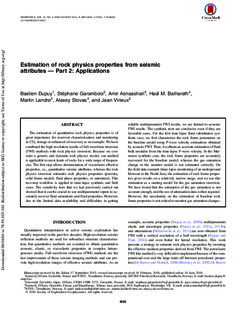| dc.description.abstract | The estimation of quantitative rock physics properties is of great importance for reservoir characterization and monitoring in CO2CO2 storage or enhanced oil recovery as an example. We have combined the high-resolution results of full-waveform inversion (FWI) methods with rock physics inversion. Because we consider a generic and dynamic rock physics model, our method is applicable to most kinds of rocks for a wide range of frequencies. The first step allows determination of viscoelastic effective properties, i.e., quantitative seismic attributes, whereas the rock physics inversion estimates rock physics properties (porosity, solid frame moduli, fluid phase properties, or saturation). This two-step workflow is applied to time-lapse synthetic and field cases. The sensitivity tests that we had previously carried out showed that it can be crucial to use multiparameter inputs to accurately recover fluid saturations and fluid properties. However, due to the limited data availability and difficulties in getting reliable multiparameter FWI results, we are limited to acoustic FWI results. The synthetic tests are conclusive even if they are favorable cases. For the first time-lapse fluid substitution synthetic case, we first characterize the rock frame parameters on the baseline model using P-wave velocity estimations obtained by acoustic FWI. Then, we obtain an accurate estimation of fluid bulk modulus from the time-lapse P-wave velocity. In the Marmousi synthetic case, the rock frame properties are accurately recovered for the baseline model, whereas the gas saturation change in the monitor model is not estimated correctly. On the field data example (time-lapse monitoring of an underground blowout in the North Sea), the estimation of rock frame properties gives results on a relatively narrow range, and we use this estimation as a starting model for the gas saturation inversion. We have found that the estimation of the gas saturation is not accurate enough, and the use of attenuation data is then required. However, the uncertainty on the estimation of baseline rock frame properties is not critical to monitor gas saturation changes. | nb_NO |
